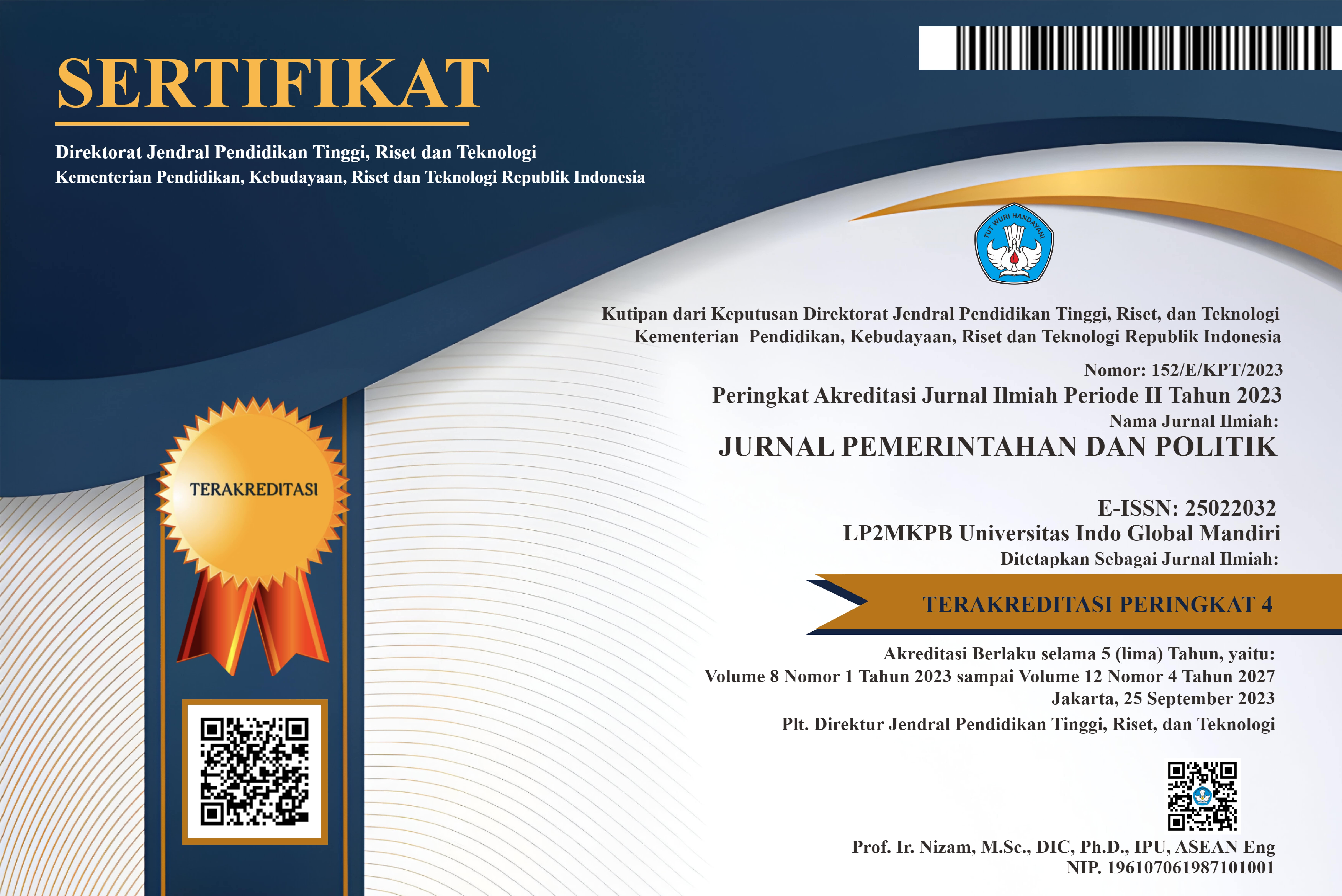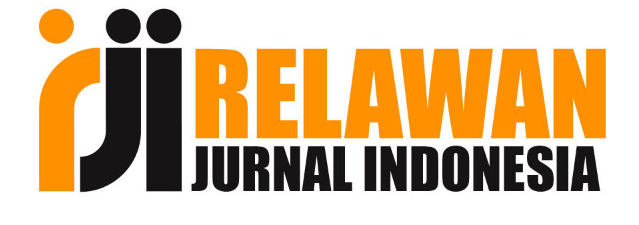Analisis Bibliometrik Tentang Mitigasi Bencana dan Pembangunan Berkelanjutan: Inisisasi Kebijakan Untuk Indonesia
DOI:
https://doi.org/10.36982/jpg.v8i4.3394Keywords:
Policy Initiation, Disaster Policy, Disaster Mitigation, Sustainable Development, Disaster ManagementAbstract
This research aims to analyze trends related to disaster mitigation and sustainable development policies through a bibliometric approach, with a special focus on implications and recommendations relevant to Indonesia. The analysis method involves searching and collecting data from Scopus, followed by data processing using the Vosviewer and Nvivo 12 Plus analysis tools. Research findings show an increasing trend in publications related to disaster mitigation and sustainable development since the early 2000s, reflecting increasing global awareness of the need for holistic and sustainable disaster management. Policy recommendations include strengthening early warning systems, developing disaster-resistant infrastructure, disaster awareness education and training, consolidating data and information, and collaboration between sectors and international partners. These are important steps in facing disaster challenges and encouraging sustainable development in Indonesia. Through an analytical approach that is bibliometrically rigorous, this research identifies knowledge gaps in the global literature related to the intersection between disaster mitigation and sustainable development, particularly in the Indonesian context. With efforts to outline findings related to research trends, map themes, and necessary policy recommendations, this research provides a solid foundation for developing integrated and responsive policy initiatives for disaster mitigation and sustainable development challenges in Indonesia. The findings of this research can provide a more comprehensive and focused view for relevant stakeholders. They can become a basis for further research and policy development to maintain community resilience and advance sustainable development in Indonesia.
References
Amarnath, G., Amarasinghe, U. A., & Alahacoon, N. (2021). Disaster risk mapping: A desk review of global best practices and evidence for south asia. Sustainability (Switzerland), 13(22), 12779. https://doi.org/10.3390/su132212779
Aung, T. M., & Lim, S. (2021). Evolution of Collaborative Governance in the 2015, 2016, and 2018 Myanmar Flood Disaster Responses: A Longitudinal Approach to a Network Analysis. International Journal of Disaster Risk Science, 12(2), 267–280. https://doi.org/10.1007/s13753-021-00332-y
Baharuddin, T., Jubba, H., Nurmandi, A., & Qodir, Z. (2022). Online Social Trust in Government: Analysis of Government Policy During the Covid-19 Pandemic. Proceedings of the First International Conference on Democracy and Social Transformation, ICON-DEMOST 2021. https://doi.org/10.4108/eai.15-9-2021.2315575
Baharuddin, T., Nurmandi, A., Qodir, Z., & Jubba, H. (2022). Bibliometric Analysis of Socio-Political Research on Capital Relocation: Examining Contributions to the Case of Indonesia. Journal of Local Government Issues (LOGOS), 5(1), 17–31. https://doi.org/https://doi.org/10.22219/logos.v5i1.19468
Baharuddin, T., Sairin, S., Nurmandi, A., Qodir, Z., & Jubba, H. (2022). Building Social Capital Online During the COVID-19 Transition in Indonesia. Jurnal Komunikasi Ikatan Sarjana Komunikasi Indonesia, 7(1), 130–142. https://doi.org/10.25008/jkiski.v7i1.607
Bakkour, D., Enjolras, G., Thouret, J. C., Kast, R., Mei, E. T. W., & Prihatminingtyas, B. (2015). The adaptive governance of natural disaster systems: Insights from the 2010 mount Merapi eruption in Indonesia. International Journal of Disaster Risk Reduction, 13, 167–188. https://doi.org/10.1016/j.ijdrr.2015.05.006
Berke, P. R., Kartez, J., & Wenger, D. (1993). Recovery after Disaster: Achieving Sustainable Development, Mitigation and Equity. Disasters, 17(2), 93–109. https://doi.org/10.1111/j.1467-7717.1993.tb01137.x
Crompton, D., Young, R. M., Shakespeare-Finch, J., & Raphael, B. (2018). Responding to Disasters: More than economic and infrastructure interve. Insights on the Depression and Anxiety, 2(1), 014–028. https://doi.org/10.29328/journal.ida.1001007
Dash, P., & Punia, M. (2019). Governance and disaster: Analysis of land use policy with reference to Uttarakhand flood 2013, India. International Journal of Disaster Risk Reduction, 36, 101090. https://doi.org/10.1016/j.ijdrr.2019.101090
Dube, E. (2020). The build-back-better concept as a disaster risk reduction strategy for positive reconstruction and sustainable development in Zimbabwe: A literature study. International Journal of Disaster Risk Reduction, 43, 101401. https://doi.org/10.1016/j.ijdrr.2019.101401
El-Masri, S., & Tipple, G. (2002). Natural disaster, mitigation and sustainability: The case of developing countries. International Planning Studies, 7(2), 157–175. https://doi.org/10.1080/13563470220132236
Grandgirard, J., Poinsot, D., Krespi, L., Nénon, J. P., & Cortesero, A. M. (2002). Costs of secondary parasitism in the facultative hyperparasitoid Pachycrepoideus dubius: Does host size matter? Entomologia Experimentalis et Applicata, 103(3), 239–248. https://doi.org/10.1023/A
Higuchi, A. (2021). Toward more integrated utilizations of geostationary satellite data for disaster management and risk mitigation. Remote Sensing, 13(8), 13081553. https://doi.org/10.3390/rs13081553
Huang, C., Tian, W., & Wang, R. (2021). Geospatial information diffusion model for inferring the demand intensity of assistance in information islands based on the Internet of intelligences for disaster mitigation. Journal of Natural Disasters, 30(2), 1–13. https://doi.org/10.13577/j.jnd.2021.0201
Ishiwatari, M., Koike, T., Hiroki, K., Toda, T., & Katsube, T. (2020). Managing disasters amid COVID-19 pandemic: Approaches of response to flood disasters. Progress in Disaster Science, 6, 100096. https://doi.org/10.1016/j.pdisas.2020.100096
Juhadi, Hamid, N., Trihatmoko, E., Herlina, M., & Aroyandini, E. N. (2021). Developing a model for disaster education to improve students’ disaster mitigation literacy. Journal of Disaster Research, 16(8), 1243–1256. https://doi.org/10.20965/jdr.2021.p1243
Kapucu, N. (2014). Collaborative governance and disaster recovery: the National Disaster Recovery Framework (NDRF) in the US. In Disaster recovery: Used or misused development opportunity (pp. 41–59). Springer Japan. https://doi.org/10.1007/978-4-431-54255-1_3
Khan, A., Gupta, S., & Gupta, S. K. (2020). Multi-hazard disaster studies: Monitoring, detection, recovery, and management, based on emerging technologies and optimal techniques. International Journal of Disaster Risk Reduction, 47, 101642. https://doi.org/10.1016/j.ijdrr.2020.101642
Lee, D. W. (2019). Local government’s disaster management capacity and disaster resilience. Local Government Studies, 45(6), 803–826. https://doi.org/10.1080/03003930.2019.1653284
Logayah, D. S., Maryani, E., Ruhimat, M., & Wiyanarti, E. (2022). The importance of disaster mitigation literacy in social studies learning. IOP Conference Series: Earth and Environmental Science, 986(1), 12015. https://doi.org/10.1088/1755-1315/986/1/012015
Malik, I., Prianto, A. L., Roni, N. I., Yama, A., & Baharuddin, T. (2023). Multi-level Governance and Digitalization in Climate Change: A Bibliometric Analysis. In S. Motahhir & B. Bossoufi (Eds.), International Conference on Digital Technologies and Applications (pp. 95–104). Springer, Cham.
Mallick, B., Rubayet Rahaman, K., & Vogt, J. (2011). Social vulnerability analysis for sustainable disaster mitigation planning in coastal Bangladesh. Disaster Prevention and Management: An International Journal, 20(3), 220–237. https://doi.org/10.1108/09653561111141682
Miranda, E. J., Kumarji, K. N., Ramesan, S., Varghese, T., Panicker, V. V., & Yadav, D. K. (2022). Application of Machine Learning Algorithms in the Mitigation Phase of Disaster Management: A Review. International Journal of Social Ecology and Sustainable Development, 13(1), 292079. https://doi.org/10.4018/IJSESD.292079
Monteil, C., Simmons, P., & Hicks, A. (2020). Post-disaster recovery and sociocultural change: Rethinking social capital development for the new social fabric. International Journal of Disaster Risk Reduction, 42, 101356. https://doi.org/https://doi.org/10.1016/j.ijdrr.2019. 101356
Pamungkas, A., & Purwitaningsih, S. (2019). Green and grey infrastructures approaches in flood reduction. International Journal of Disaster Resilience in the Built Environment, 10(5), 343–362. https://doi.org/10.1108/IJDRBE-03-2019-0010
Parajuli, R. R. (2020). Citizen disaster science education for effective disaster risk reduction in developing countries. Geoenvironmental Disasters, 7(1), 1–4. https://doi.org/10.1186/s40677-020-00150-2
Peng, L., Tan, J., Lin, L., & Xu, D. (2019). Understanding sustainable disaster mitigation of stakeholder engagement: Risk perception, trust in public institutions, and disaster insurance. Sustainable Development, 27(5), 885–897. https://doi.org/10.1002/sd.1948
Prianggodo, C. A. (2023). Pembangunan Ikn Sebagai Mercusuar Strategis (Kajian Kritis Dalam Perspektif Sustainable Development). Jurnal Pemerintahan Dan Politik, 8(1). https://doi.org/10.36982/jpg.v8i1.2898
Rahmat, H. K., Widana, I. D. K. K., Basri, A. S. H., & Musyrifin, Z. (2021). Analysis of potential disaster in the new capital of indonesia and its mitigation efforts: A qualitative approach. Disaster Advances, 14(3), 40–43.
Rehman, J., Sohaib, O., Asif, M., & Pradhan, B. (2019). Applying systems thinking to flood disaster management for a sustainable development. International Journal of Disaster Risk Reduction, 36, 101101. https://doi.org/10.1016/j.ijdrr.2019.101101
Rehman, S., Sahana, M., Hong, H., Sajjad, H., & Ahmed, B. Bin. (2019). A systematic review on approaches and methods used for flood vulnerability assessment: framework for future research. Natural Hazards, 96(2), 975–998. https://doi.org/10.1007/s11069-018-03567-z
Rouhanizadeh, B., & Kermanshachi, S. (2020). Post-disaster reconstruction of transportation infrastructures: Lessons learned. Sustainable Cities and Society, 63, 102505. https://doi.org/10.1016/j.scs.2020.102505
Schilderman, T. (2004). Adapting traditional shelter for disaster mitigation and reconstruction: Experiences with community-based approaches. Building Research and Information, 32(5), 414–426. https://doi.org/10.1080/0961321042000250979
Setyowati, D. L., & Amin, M. (2023). Technology-based disaster mitigation transformation for Geo-Hazard risk reduction. AIP Conference Proceedings, 2491, 105512. https://doi.org/10.1063/5.0105512
Shah, A. A., Ye, J., Shaw, R., Ullah, R., & Ali, M. (2020). Factors affecting flood-induced household vulnerability and health risks in Pakistan: The case of Khyber Pakhtunkhwa (KP) Province. International Journal of Disaster Risk Reduction, 42, 101341. https://doi.org/10.1016/j.ijdrr.2019.101341
Shokri, A., Sabzevari, S., & Hashemi, S. A. (2020). Impacts of flood on health of Iranian population: Infectious diseases with an emphasis on parasitic infections. Parasite Epidemiology and Control, 9, e00144. https://doi.org/10.1016/j.parepi.2020.e00144
Sihombing, Y. I., Adityawan, M. B., Chrysanti, A., Widyaningtias, W., Farid, M., Nugroho, J., Kuntoro, A. A., & Kusuma, M. A. (2020). Tsunami Overland Flow Characteristic and Its Effect on Palu Bay Due to the Palu Tsunami 2018. Journal of Earthquake and Tsunami, 14(2), 2050009. https://doi.org/10.1142/S1793431120500098
Tsai, M. H., Chang, Y. L., Shiau, J. S., & Wang, S. M. (2020). Exploring the effects of a serious game-based learning package for disaster prevention education: The case of Battle of Flooding Protection. International Journal of Disaster Risk Reduction, 43, 101393. https://doi.org/10.1016/j.ijdrr.2019.101393
Uddin, K., & Matin, M. A. (2021). Potential flood hazard zonation and flood shelter suitability mapping for disaster risk mitigation in Bangladesh using geospatial technology. Progress in Disaster Science, 11, 100185. https://doi.org/10.1016/j.pdisas.2021.100185
Usman, F., Murakami, K., Deguchi, C., & Cahyaning, I. (2019). Information and communication technology in tsunami disaster mitigation related to evacuation. Disaster Advances, 12(3), 1–5.
Watanabe, T., Cullmann, J., Pathak, C. S., Turunen, M., Emami, K., Ghinassi, G., & Siddiqi, Y. (2018). Management of Climatic Extremes with Focus on Floods and Droughts in Agriculture. Irrigation and Drainage, 67(1), 29–42. https://doi.org/10.1002/ird.2204
Weichselgartner, J. (2001). Disaster mitigation: The concept of vulnerability revisited. Disaster Prevention and Management: An International Journal, 10(2), 85–94. https://doi.org/10.1108/09653560110388609
Widayat, R. M., Nurmandi, A., Rosilawati, Y., Natshir, H., Syamsurrijal, M., & Baharuddin, T. (2022, April). Bibliometric Analysis and Visualization Articles on Presidential Election in Social Media Indexed in Scopus by Indonesian Authors. In 1st World Conference on Social and Humanities Research (W-SHARE 2021) (pp. 146-151). Atlantis Press. https://doi.org/10.2991/assehr.k.220402.032
Yu, M., Yang, C., & Li, Y. (2018). Big data in natural disaster management: A review. Geosciences (Switzerland), 8(5), 165. https://doi.org/10.3390/geosciences8050165
Zheng, J., Xu, W., Tao, A., Fan, J., Xing, J., & Wang, G. (2023). Synergy between coastal ecology and disaster mitigation in China: Policies, practices, and prospects. Ocean and Coastal Management, 245, 106866. https://doi.org/10.1016/j.ocecoaman.2023.106866
Zurita, M., Lourdes, M. de, Cook, B., Thomsen, D. C., Munro, P. G., Smith, T. F., & Gallina, J. (2018). Living with disasters: social capital for disaster governance. Disasters, 42(3), 571–589. https://doi.org/10.1111/disa.12257









